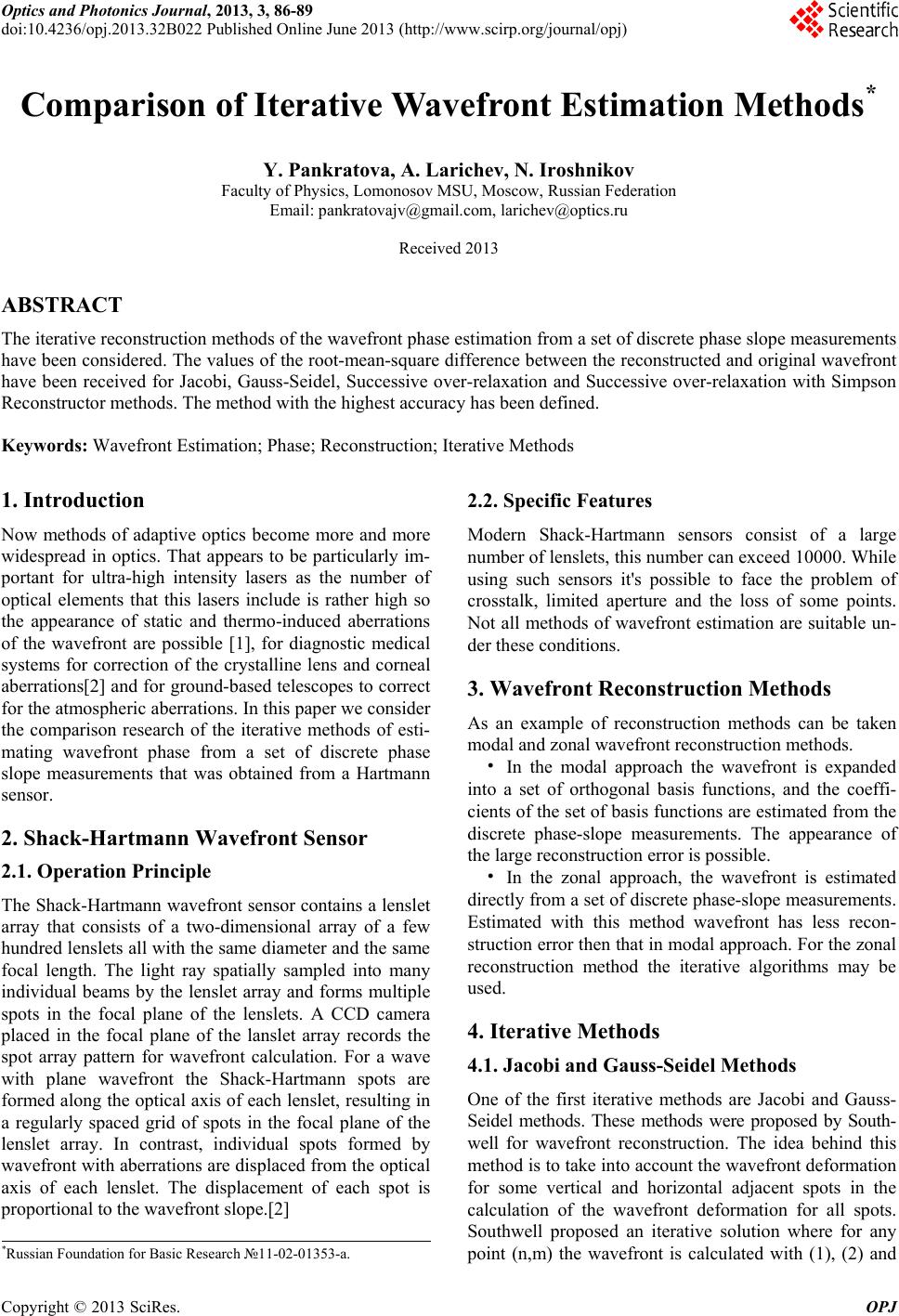
Optics and Photonics Journal, 2013, 3, 86-89
doi:10.4236/opj.2013.32B022 Published Online June 2013 (http://www.scirp.org/journal/opj)
Comparison of Iterative Wavefront Estimation Methods*
Y. Pankratova, A. Larichev, N. Iroshnikov
Faculty of Physics, Lomonosov MSU, Moscow, Russian Federation
Email: pankratovajv@gmail.com, larichev@optics.ru
Received 2013
ABSTRACT
The iterative reconstruction methods of the wavefront phase estimation from a set of discrete phase slope measurements
have been considered. The values of the root-mean-square difference between the reconstructed and original wavefront
have been received for Jacobi, Gauss-Seidel, Successive over-relaxation and Successive over-relaxation with Simpson
Reconstructor methods. The method with the highest accuracy has been defined.
Keywords: Wavefront Estimation; Phase; Reconstruction; Iterative Methods
1. Introduction
Now methods of adaptive optics become more and more
widespread in optics. That appears to be particularly im-
portant for ultra-high intensity lasers as the number of
optical elements that this lasers include is rather high so
the appearance of static and thermo-induced aberrations
of the wavefront are possible [1], for diagnostic medical
systems for correction of the crystalline lens and corneal
aberrations[2] and for ground-based telescopes to correct
for the atmospheric aberrations. In this paper we consider
the comparison research of the iterative methods of esti-
mating wavefront phase from a set of discrete phase
slope measurements that was obtained from a Hartmann
sensor.
2. Shack-Hartmann Wavefront Sensor
2.1. Operation Principle
The Shack-Hartmann wavefront sensor contains a lenslet
array that consists of a two-dimensional array of a few
hundred lenslets all with the same diameter and the same
focal length. The light ray spatially sampled into many
individual beams by the lenslet array and forms multiple
spots in the focal plane of the lenslets. A CCD camera
placed in the focal plane of the lanslet array records the
spot array pattern for wavefront calculation. For a wave
with plane wavefront the Shack-Hartmann spots are
formed along the optical axis of each lenslet, resulting in
a regularly spaced grid of spots in the focal plane of the
lenslet array. In contrast, individual spots formed by
wavefront with aberrations are displaced from the optical
axis of each lenslet. The displacement of each spot is
proportional to the wavefront slope.[2]
2.2. Specific Features
Modern Shack-Hartmann sensors consist of a large
number of lenslets, this number can exceed 10000. While
using such sensors it's possible to face the problem of
crosstalk, limited aperture and the loss of some points.
Not all methods of wavefront estimation are suitable un-
der these conditions.
3. Wavefront Reconstruction Methods
As an example of reconstruction methods can be taken
modal and zonal wavefront reconstruction methods.
• In the modal approach the wavefront is expanded
into a set of orthogonal basis functions, and the coeffi-
cients of the set of basis functions are estimated from the
discrete phase-slope measurements. The appearance of
the large reconstruction error is possible.
• In the zonal approach, the wavefront is estimated
directly from a set of discrete phase-slope measurements.
Estimated with this method wavefront has less recon-
struction error then that in modal approach. For the zonal
reconstruction method the iterative algorithms may be
used.
4. Iterative Methods
4.1. Jacobi and Gauss-Seidel Methods
One of the first iterative methods are Jacobi and Gauss-
Seidel methods. These methods were proposed by South-
well for wavefront reconstruction. The idea behind this
method is to take into account the wavefront deformation
for some vertical and horizontal adjacent spots in the
calculation of the wavefront deformation for all spots.
Southwell proposed an iterative solution where for any
point (n,m) the wavefront is calculated with (1), (2) and
*Russian Foundation for Basic Research №11-02-01353-a.
Copyright © 2013 SciRes. OPJ